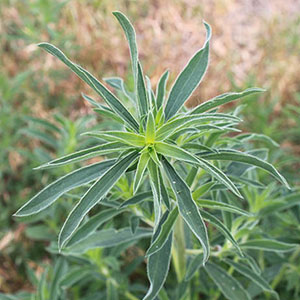Kochia, an annual weed, requires a mix of herbicides early in the year to prevent it from disturbing crop production, said Kansas State University weed scientist Jeremie Kouame.
“Now is the time to finalize plans for kochia control for the upcoming growing season,” Kouame said. “In western Kansas, kochia emerges very early. In February, for example, it started emerging, and so those first flushes of weeds are going to use the moisture of the soil, which can be detrimental to crops.”
Kouame urges producers to apply a combination of pre-emergence pesticides to restrict initial kochia growth.
“If we want to achieve a good yield, we need to get those first flushes controlled. The options that work well for kochia are a tank mix of dicamba and atrazine,” he said.
Kochia control protocols call for yearly treatment, according to Kouame.
“If last year someone had a problem and the plants were not well controlled and they allowed them to produce new seeds, then those seeds are going to come as seedlings this year and will be detrimental during the growing season,” he said.
Monitoring fields consistently for a kochia appearance serves as a crucial first step in battling the troublesome weed.
“One of the best weed management tools we have are our footprints in the field. Whether that’s an actual farmer or whether that’s their agronomists or a crop consultant that they’ve hired on, boots in the field cannot be replaced, although drones are also a useful tool,” K-State weed specialist Sarah Lancaster said.
Additionally, Lancaster advises farmers to stay vigilant for herbicide resistant kochia.
“Even though most of our farmers are doing a really good job of putting these products out there in combination, I’ve still spent a lot of time this winter having folks be on the lookout for signs of Group 14 resistance,” she said.
Kouame noted that a recent multi-state, crop study indicates great success in treating unaffected kochia in certain plant types.
“The result of this research showed that the herbicide program used for corn controlled 99% of glyphosate-resistant Kochia,” Kouame said.
The herbicide program used in the study utilized Degree Xtra followed by Impact, Verdict followed by Status, and Balance Flexx followed by Laudis plus AAtrex.
“We know from the literature that these herbicides tend to synergize,” Kouame said. “When they are mixed, their efficacy increases, so we can achieve better control of weeds.”
Lancaster proposes another herbicide, Verdict, for remedying kochia invading sorghum fields.
“Verdict is a combination of dimethenamid-p and saflufenacil. So, as we think about programs ahead of grain sorghum, Verdict can really play an important role there because it’s going to give us some residual activity, as well as some burndown activity on both kochia and pigweeds,” she said.
Note: Brand names used in this article are for identification purposes only and do not indicate endorsement by Kansas State University of any specific product.



